The heritage discourse: An aliba for slow development of the Oaxaca city
Keywords:
Urban history, Mexico, Oaxaca, city of Oaxaca, historical center, 20th century, historic centre of Oaxaca, tourism, cultural and monumental heritageAbstract
The archeological richness of the state of Oaxaca, the wide variety of local art, crafts and festivities, the ethnic and linguistic diversity of its people and the perception of its capital as an “indigenous” and “colonial” city are characteristics that have been used consistently to encourage tourism while disregarding other potential paths towards economic and cultural development.
The almost exclusive focus on this heritage as a tourist attraction has greatly influenced the political decisions and actions taken by governing offices in numerous spheres; these range from public budgeting for education and culture to urban and architectural development where its influence is particularly noticeable, as evidenced by related regulations, public works, infrastructure and services.
An examination of these developments in the city of Oaxaca during the 20th century illustrates the negative consequences that tourism, as well as the exploitation of a cultural heritage, can have on the development of cities with similar characteristics.
Downloads
Downloads
Published
How to Cite
Issue
Section
License
The content of articles which are published in each edition of Habitat Sustentable, is the exclusive responsibility of the author(s) and does not necessarily represent the thinking or compromise the opinion of University of the Bio-Bio.
The author(s) conserve their copyright and guarantee to the journal, the right of first publication of their work. This will simultaneously be subject to the Creative Commons Recognition License CC BY-SA, which allows others to share-copy, transform or create new materials from this work for non-commercial purposes, as long as they recognize authorship and the first publication in this journal, and its new creations are under a license with the same terms.![]()























